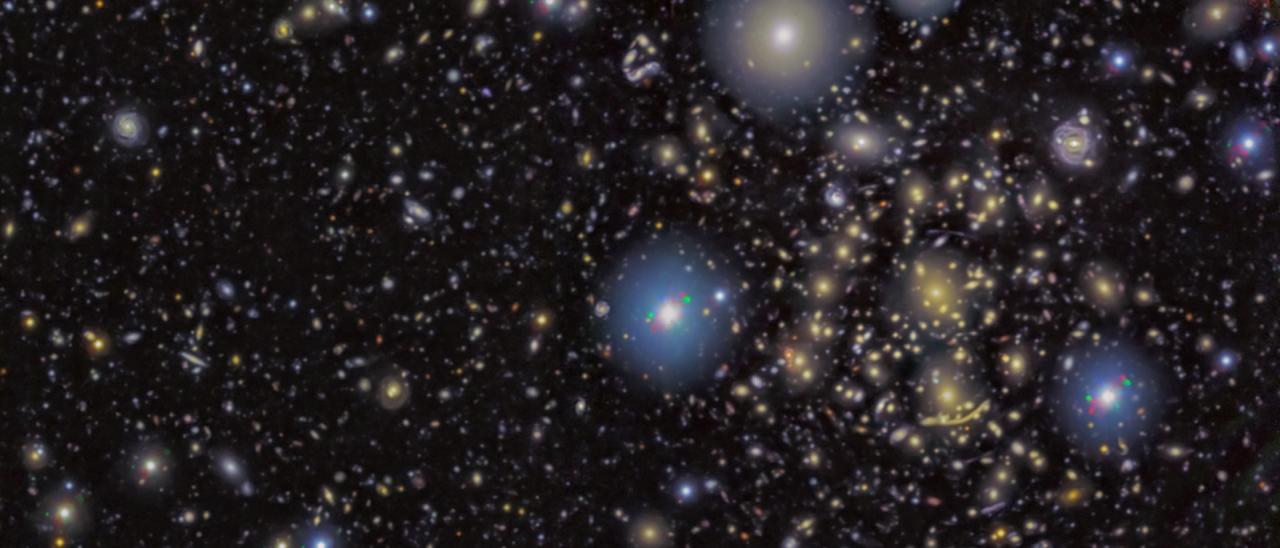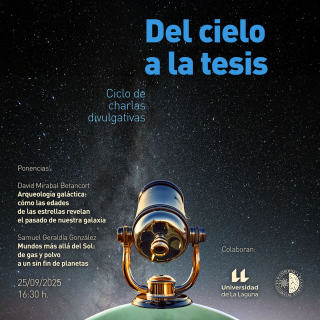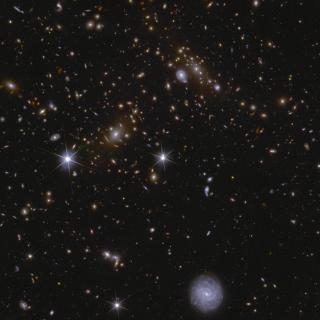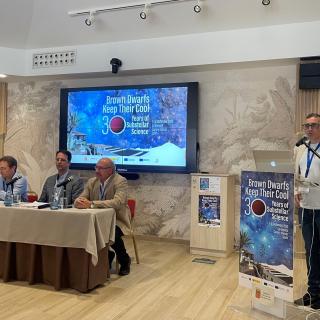One of the most interesting questions for astrophysicists for the past few decades is how and when did the first galaxies form. One of the possible answers to “how” is that star formation in the first galaxies took place at a steady rate, building up a system with increasing mass. Another possibility is that the formation was more violent and discontinuous, with intense bursts of star formation, on short timescales, triggered by events such as galaxy mergers and strong concentrations of gas.
An international research team, led from the Centre of Astrobiology (CAB, CSIC-INTA) with participation from the Instituto de Astrofísica de Canarias (IAC), in collaboration with researchers form the United Kingdom, Mexico and Chile, have investigated the origin of the first stars and structures in the Universe. They analysed data from the Frontier Fields programme, the most ambitious project carried out with the Hubble Space Telescope (HST) and the Gran Telescopio Canarias (GTC or GRANTECAN), the largest optical and infrared telescope in the world, sited at the Roque de los Muchachos Observatory (Garafía, La Palma). The results are published today in the journal Monthly Notices of the Royal Astronomical Society (MNRAS).
“The first galaxies might have added new stars slowly but continually, without much acceleration, systematically converting gas into relatively small stars over long periods of time. Or the formation could have been in bursts, with short periods of formation producing very big stars, which could shape the whole galaxy and cause it to stop its activity for a while or permanently”, explains Pablo G. Pérez-González, a researcher at the CAB, a co-author of the article, and leader of the international collaboration working on the study. “Each of the scenarios is linked to different processes, such as the mergers of galaxies or the influence of supermassive black holes, and have an effect on when and how different elements were formed, such as carbon and oxygen, which are essential for life”, he adds.
In an article published recently about this subject, the astronomers looked for nearby analogues to the first galaxies formed in the Universe so that they could study them in much greater detail. Alex Griffiths, a researcher at Nottingham University and first author on the paper says: “Until we have the new James Webb Space Telescope we will not be able to observe the first galaxies formed in the Universe, they are too faint. So we look for similar objects in the nearby Universe and we analyse them with the most powerful telescopes we have at present”.
The way this work was done was to combine the power of the most advanced telescopes, such as the HST and the GTC, with the help of “natural telescopes”. Chris Conselice, a co-author of the article, and supervisor of the doctoral thesis of Griffiths, comments on this strategy: “Some galaxies are found in large groups, which we call clusters, which contain a large amount of matter in the form of stars, but also in the form of gas and of dark matter. This mass is so big, that it can curve space-time, and the clusters act as “natural telescopes”. These, known as gravitational lenses, let us observe distant, faint galaxies more brightly and with better spatial resolution, it is as if we were using a lens created by the Universe itself”. Observations of some of these clusters acting as gravitational telescopes are the basis of the Frontier Fields project, the most ambitious programme of the Hubble Space Telescope.

In the study published in MNRAS the authors combined the power of gravitational lensing by some of the most massive clusters in the Universe with very deep images from the GTC taken in the SHARDS project (Survey for high-z Red and Dead Sources) with the aim of finding and studying some of the smallest and faintest galaxies in the local Universe.
The SHARDS project consisted in taking with the GTC the very deepest images of the field observed with the Hubble, using 25 intermediate passband filters which together cover the wavelength range from 500 to 940 nanometres. “These selective images allow us to analyse how the light of very faint galaxies is distributed in the different colours of the visible wavelength range. And this allows us to detect the gas heated by newly formed stars, which emit at specific wavelengths (emission lines) in a process similar to that in a neon lamp”, explains Romano Corradi, the director of GRANTECAN.
“To obtain these images the SHARDS project needed 120 hours of observation with the GTC. The images, which can be combined into a single very impressive image in pseudo colour, are a real mine of information about the thousands of galaxies detected”, stresses Antonio Cabrera, head of Scientific Operations of GRANTECAN.
“Our main result is that the start of galaxy formation is irregular, with very violent periods of star formation followed by periods when the galaxy is dormant”, adds Griffiths. “It is not likely that galaxy mergers played a major role in triggering those bursts of star formation; it is more probable that this was due to other causes which caused the pile-up of gas, we need to investigate further”, he concluded.
The Gran Telescopio Canarias and the Observatories of the Instituto de Astrofísica de Canarias (IAC) are part of the network of Singular Scientific and Technical Infrastructures of Spain.
Article: Griffiths et al. “Emission Line Galaxies in the SHARDS Frontier Fields I: Candidate Selection and the Discovery of Bursty Hα Emitters”. Monthly Notices of the Royal Astronomical Society (MNRAS). DOI: https://doi.org/10.1093/mnras/stab2566
Contact at the IAC:
- Romano Corradi: romano.corradi [at] gtc.iac.es (romano[dot]corradi[at]gtc[dot]iac[dot]es)
- Antonio Cabrera: antonio.cabrera [at] gtc.iac.es (antonio[dot]cabrera[at]gtc[dot]iac[dot]es)



